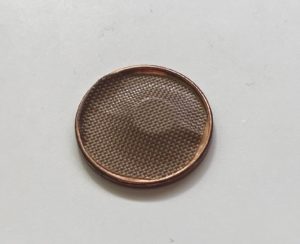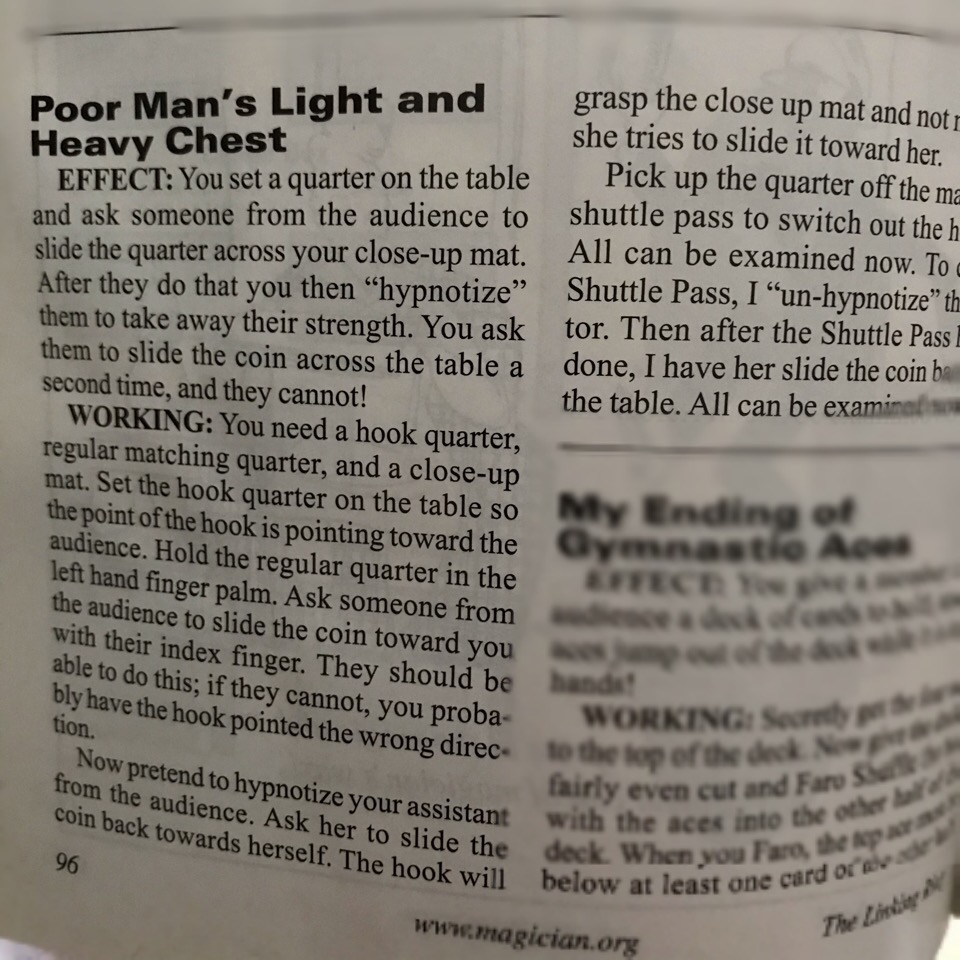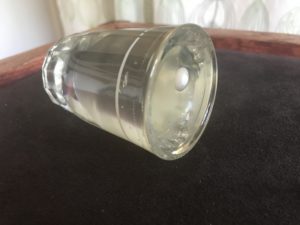In yesterday’s blog post about progressive anagrams, I mentioned a good way to use them for internet shows without any memory work. That doesn’t solve the problem of people not knowing how to spell words. The easy way is to use simple, common words, and not things like astrological signs like, “Sagittarius” which took me 4 tries to correctly spell it before I did a web search to figure it out just now.
The next problem and what I think is the biggest weakness is when you get the letters wrong. There are some instances where you will get no letters wrong, but you can’t count on that. There are also some where you’ll only get one wrong and immediately know the word, which is the problem. It feels like you are doing exactly what you are doing, figuring out the word by the letters.
To remove the idea that you’re just guess based on the letters, you need a prediction. Something physical to show that you knew it all along. This could be a written prediction, or whatever. A simple solution (depending on your words) would be a nail writer. Another easy way would be an index of the words, or multiple out set up.
What the prediction does is makes it harder to backtrack the method. If people talk after the show it ends up being, “If he was just guessing, then how did the prediction match what I was thinking of?” Taking it a step further makes it a more solid trick!
Category: Tricks
Progressive Anagrams…
Soon after I got seriously into magic I picked up a copy of the book Thabbatical by Phil Goldstein (Max Maven). It’s got several progressive anagram tricks in the book. If you don’t know what a progressive anagram is, it’s a way of figuring out a word that someone is thinking of by asking them if certain letters are in the word. Everytime you get a “NO”, you move to a new list. In a good list, by the time you get to the second “NO” you know the word.
The huge problem with using a progressive anagram is the person needs to be able to spell the word correctly in their head. Sure you can have them take the word off of a list, but I think that takes ways what makes this type of trick work, and that’s that you don’t need any props.
The other challenge is that you need to memorize a flow chart of letters and words. It’s not super hard, but it does take work and you need to keep in practice. However, right now with use all stuck at home and doing magic over the internet, you can easily do progressive anagrams without memorizing anything! The way to do it is to simply print it out and put it someone outside your camera’s field of view. No memory work, it’s plug and play!
The Penny Solution…
In yesterday’s blog post, I mentioned it took a bit of work figuring out what to do with the penny in the trick where a penny changes into two silver dollars. The challenge was that the coin change happens immediately, however I need to keep the coin hidden for the whole routine. Based on the conditions I posted I can’t just ditch it as my hands need to remain in the frame. Adding to the problem is that I also have two coins finger palmed the entire routine (until the end).

The solution I came up with, which should have been pretty obvious was to attach attach a magnet to the penny as the silver dollars already have magnet in them. I took the penny shell from a Dime and Penny set and used teflon tape to hold the magnet.
I figured using a shell would allow the penny to sit flat on on the silver dollar. The flatter it sat, the less chance there would be for me to accidentally knock it off, and it won’t rattle as the coin moved.

The “penny solution” brings me back to something Nick Lewin always says, I love how elaborate this 30 second coin routine has become!
Conditions on a Coin Routine…
The last couple of days I created and refined a coin routine. Here are the two routines and the conditions:
Initially the conditions were:
- Viewed from the front
- Done for the camera
- No table
- Face must be framed
I will say that I initially fudged the face must be framed because I put the coin in my pocket, however there’s still action by my face as that’s where my right hand stays holding a coin.
After coming up the first version, I added a couple more conditions:
- Hands stay in frame
- Usable in a LIVE show with video projection
- Able to set up quickly
With the second set of conditions, I’m thinking about actually using the routine. In the second version, I’m playing the the camera for the two times the coin disappears from one hand and reappears in the other, but it will still work live. The set up quickly condition is huge, I need to be able to reach into my case, grab the coins and be good to go.
Then there’s a small challenge with the condition of my hands not leaving the frame. I have the stupid penny to keep hidden after it changes into the two silver dollars. It sounds simple, but was a pain to figure out how…until I came up with a very simple and obvious solution to holding out the penny for almost the whole routine.
The next step would be to start to work on a verbal routine, or at least intro, to get more than 30ish seconds out of the routine.
Continuing Creating a Coin Routine…
The coin routine that I started yesterday started with a penny turning into two silver dollars. One silver dollar repeated traveled from the pocket to the hand and for a finish one of the silver dollars turned clear. It’s a decent routine, however after playing with it, I added a couple more conditions (I’ll write about the conditions tomorrow) and here’s what the routine changed into:
The first big difference is the routine is about 17 seconds shorter. I took the coin going from the pocket to the hand, that I felt was pretty redundant after I did it more than twice. It doesn’t feel as impossible with a coin as it does with a ball. It’s interesting that the routine started with a billiard ball manipulation premise, however moved away from that.
The ending with both coins turning clear makes more sense than just one of them doing and the final display of one in each hand is better.
Working On A Coin Routine…
A bit ago I noticed some coins on my desk, and figured I’d start playing with putting together a quick coin routine. To start the routine I gave myself a few conditions that it had to adhere to and I’ll get to those in a future blog post. Here’s what I put together:
When I started playing with the coins one thing that I quickly realized is that I could almost do a billiard ball manipulation routine with them. Once you have the initial change from a penny to two silver dollars, the routine is essentially Percy Abbott’s Perpetual Ball routine.
Next up the routine needed an ending. I don’t think that producing 4 or 5 silver dollars would have the same impact as producing 5 billiard balls. Luckily a clear coin caught my eye and I threw that into the mix. I think it gives it an ending.
Virtual Card To Envelope
A few days ago I posted about a gimmicked envelope that was designed for use during a virtual show. At it’s core it’s an named card to envelope. Here’s the basic routine:
In the video above I do the routine with a gag card in the envelope. Personally I think the gag card makes the trick a little bit dirtier. This helps it avoid the Too Perfect Theory. My thinking was that the 52 on 1 card puts more time between the load and the reveal.
This will be published in Vanish Magazine soon.
Light and Heavy…
One trick that I’ve been interested in for a while is the Light and Heavy Box premise. This was originally done with a box that someone could lift, or couldn’t at the will of the magician. This is a trick that I’ve used in my stage show during a couple school assembly tours. It’s a great trick and gets good reactions.
About a dozen years ago I published a version that was close up that used a coin:

A couple of days ago I saw that Wayne Fox was offering a discount on a download of his Light / Heavy Project. This is an interesting idea, and it was a great purchase. Personally, I don’t think it will make it into my core close up set, however I do think it’s something that I’d do for a group that I’m really connecting with.
If you like the light and heavy premise this download is worth checking out!
Shell Game Ending…
If you read this blog or follow me on social media, you know I’m not the Three Shell Game. I’ve come up with several original takes on the classic trick, which is great for a routine that’s basically been unchanged decades. I just built an ending for the shell game that I think is pretty cool.
Before I tell you what I did, let me tell you the two types of tricks that I think are usually the most lazy ways of being creative with magic. They are items that are hollow and turn solid and items that turn into glass (or clear plastic). Yes, there are execptions, like when Jerry Andrus and Danny Korem first did the Omni Deck. If you take a marker an turn it clear…great, but unless you have a really original take on the switch, it’s just a color change and no different from turning the marker from red to black.
So now, let’s get back to the shell game. Personally I’ve never done the ending where the shells turn solid. Why? I don’t think it makes sense. It’s a kicker ending that’s not really logical and doesn’t really move the ending forward. It’s too different from what has happened the whole time. It’s a “what?” moment because it thinking of the audience has to shift a lot from what was happening the whole routine. It’s almost like it’s the beginning of a new routine.
How did I fix the solid shells? I took it a step further. I used it as the starting point for another effect. Here’s how the routine plays. You do a few shell sequences, then cover a shell and pea with a shot glass. They are mixed around and guess where the pea is. When they lift the shot glass, then the shell, they see no pea, and then they discover the shell is solid. Now it’s a mystery they just discovered. They will turn over the other two shells to check them, and they are solid as well. Having them discover the solid shell is soo much better than you revealing it.
Now for the new ending:
When they look at the shotglass that’s sitting on the table, they see the pea under it. When they pick up the shotglass, they realize the shotglass is solid! The pea is embedded in the solid shotglass!

This is a solid (pun intended) ending for the solid shell game. It takes the routine one step forward to an ending that’s more logical than just the solid shells.
Routine With Gimmicked Envelope…
I’m going to try to put together some sort of a routine with the gimmicked envelope that was in yesterday’s blog post. Essentially this is an envelope that you can load things into while it’s closed. There’s not much to the envelope, basically it has a hidden trapdoor that allows you to load it thru the bottom. This post isn’t really concerned with the mechanics, it’s more concerned with what to do with it.
My first idea was for a trick over Zoom. What happens is you show the envelope and have someone name a card and it’s in the envelope. How I’m doing it is having someone off camera load the card into the envelope what the bottom of the envelope is off screen for a second. I’ve done this a couple of times and it works.
My second idea is to expose the camera edge with a fake explanation. You show a side view of the trick and what happens off camera is a “Rube Goldberg” sort of way to find the card and put it into the envelope. I think this is a fun blow off and gives you more time out of the trick. However the trick needs a kicker of some sort to so that it has an ending instead of just a blow off.
